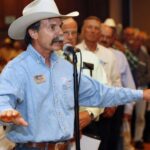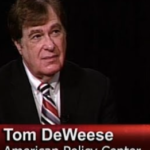No. No. No.
That was the resounding message that area ranchers delivered to federal agriculture officials here to gather their opinions on a proposed mandatory National Animal Identification System.
More than 300 ranchers packed into a meeting room at the Rushmore Plaza Holiday Inn for a U.S. Department of Agriculture listening session on the proposed NAIS. The system would use a combination of identification devices and computerized records to track livestock in the event of a disease outbreak.
Of the approximately 60 people who spoke Thursday morning, only two voiced support for the proposed mandatory system of animal ID.
Skip Waters, a rancher from Moorcroft, Wyo., was typical of those adamantly opposed to what they see as a costly, burdensome, off-target and unnecessary system that would be forced on them.
“It’s not just a bad idea,” Waters said. “It’s a horrible idea. It’s ludicrous.”
South Dakota Rep. Betty Olson, R-Bison, said the costs of ear tags, especially a radio frequency ID tag, plus those of maintaining computer records, would put many producers out of business.
Olson said South Dakota and other western states already have a good system for identifying individual cattle — the hot-iron brand.
Justin Tupper, who manages St. Onge Livestock, said he worries that a national ID system would snarl the flow of cattle on sale days.
He said electronic wands that read radio frequency ear tags are unreliable about 20 percent of the time. The delays could jam up traffic in South Dakota sale barns, which process up to 3 million cattle each year.
Larry Nelson of Buffalo, president of the South Dakota Stockgrowers Association, said the proposed system’s requirement to record all movement of cattle within 24 hours, including between ranches, would be impossible to meet in far-flung ranges in the West, where cattle often drift into neighbor’s pastures and calves can die and not be found for weeks or months.
“Most of these people here cannot comply,” Nelson said of the crowd of western ranchers. “It’s going to make us lawbreakers.”
The Stockgrowers Association and its national affiliate, R-CALF USA, oppose any sort of national ID system, even a voluntary one.
R-CALF CEO Bill Bullard of Billings, Mont., was among those who blasted USDA for allowing cattle imports from Canada, despite its outbreak of mad cow disease; from Mexico, despite its problems with tuberculosis and fever ticks; and from Argentina, despite its problems with foot and mouth disease.
Bullard said the U.S. cattle industry has been shrinking since 1996, losing 19,000 ranchers a year.
“Our markets are broken. Our industry is broken,” Bullard said. “It’s happened because USDA has turned its back on us livestock producers.”
Bullard drew a standing ovation.
Two speakers supported the idea of mandatory animal ID.
Brad Greenway of Mitchell, a member of the South Dakota Pork Council, said establishing a mandatory animal ID system is critical to the viability of the pork industry.
“The real advantage is that it places a searchable data base in each state for all premises holding livestock,” Greenway said. “In the event of an animal disease outbreak, it will allow animal health professionals to efficiently locate the premises that have been exposed. The efficiency of a mandatory system will allow an outbreak to be brought under control and eradicated more quickly.”
Todd Mortenson of Hayes, president of the South Dakota Cattlemen’s Association, said a voluntary ID system is preferable for the livestock herd as a whole. “However SDCA supports mandatory ID in breeding stock as a first step toward addressing animal disease control,” Mortenson said.
Mortenson said consumers and trading partners are demanding increased traceability and accountability from livestock producers. “Today the U.S. is the only developed country in the world without a comprehensive animal ID and tracking system,” Mortenson said.
One of the senior USDA people present at the listening session, Dr. David Morris of Fort Collins, Colo., acknowledged many of the objections raised Thursday, including the importance of preventing diseased animals from crossing the U.S. border.
“But that is a separate issue from being able to provide traceability for our own existing animal diseases as well as potential foreign animal disease introductions,” Morris said.
Morris said the successes of many current disease surveillance programs, such as those for brucellosis, have led to a problem: fewer producers and fewer cattle participating in those programs.
R-CALF’s Bullard admitted that USDA has a legitimate concern about the decline in disease program participation. He said if Vilsack would dump the NAIS, groups like his would work with the USDA to increase participation in those disease surveillance programs.
Bullard also said he is more optimistic about the chance for stopping NAIS, now that Vilsack, the former governor of Iowa, is secretary of agriculture.
“This was a train that looked unstoppable until Secretary Vilsack announced that he was not going to proceed until he learned from cattle producers and livestock producers what their concerns are,” Bullard said.
The USDA heard the full litany of concerns in Rapid City on Thursday.
USDA officials said the Rapid City listening session, the eighth in the series, had the largest turnout so far. Another five listening sessions are scheduled.
Contact Steve Miller at 394-8415 or steve.miller@rapidcityjournal.com.




Hey everyone. I’m hoping to meet new friends here so drop me a note when you
get a chance.
I hope to make some quality posts soon but first I have to look around the forum and
familiarize myself with everyone and the forum.
Bye for now. lol
***************************************************
Biggest Loser of All Time